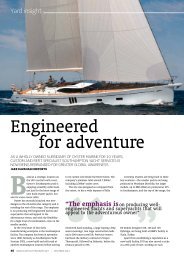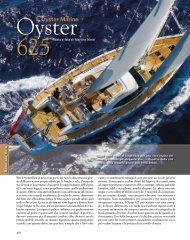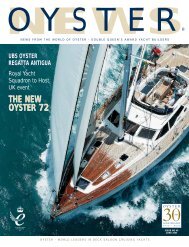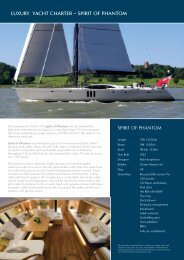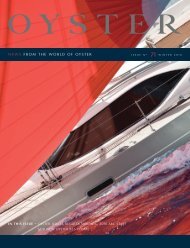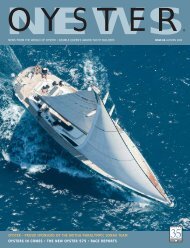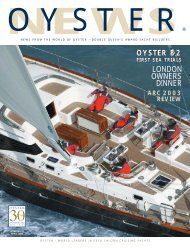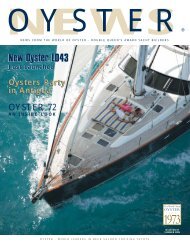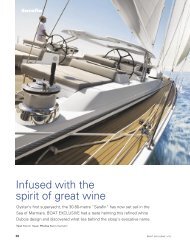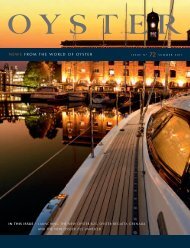Create successful ePaper yourself
Turn your PDF publications into a flip-book with our unique Google optimized e-Paper software.
WHILE OYSTER 885 NUMBER ONE CIRCLESTHE GLOBE IN THE INAUGURAL OYSTERWORLD RALLY, WE JOINED 885-02 KARIBUON PASSAGE FROM PALMA, MALLORCA,TO PORTO CERVO, SARDINIA, FOR AHANDS-ON REVIEW OF THIS NEWRANGE-TOPPING FLAGSHIPTEXT BY MIKE OWEN »PHOTOS BY MIKE JONES & INGRID ABERY104 OYSTER NEWS SUMMER 2013
AS SUNRISE FLARED BEHIND THE SPIRES of Palma’s emblematicca<strong>the</strong>dral, <strong>Oyster</strong> 885 Karibu’s slipping lines forsook <strong>the</strong> marina, headingfor <strong>the</strong> Cabrera Straights off <strong>the</strong> south-eastern tip of <strong>the</strong> island, <strong>the</strong>n ENEfor Sardinia’s crown. Fuelled, watered and with a pantry well stocked fora much longer voyage, our landfall was just 340 miles distant equivalentonly to moments away for an <strong>Oyster</strong>. But every mile was to be enjoyed.First launched last autumn, <strong>the</strong> new flagship <strong>Oyster</strong> 885 slides in beneath<strong>the</strong> custom-built 100 and 125, but ahead of her next series-built sibling,<strong>the</strong> new 825, due to launch later this year. With <strong>the</strong> fifth 885 already in <strong>the</strong>construction hall in such short time, <strong>the</strong> benefits of <strong>Oyster</strong>’s serial buildingmethodology become very clear: <strong>the</strong> in<strong>here</strong>nt cost savings of shared toolsand shortened build time; <strong>the</strong> inclusion of proven, reliable mechanical,electrical and electronic packages; yet still <strong>the</strong> ability to customiseextensively for discreet differences between every new launching.FIRST LAUNCHED JUST LAST AUTUMN THE NEW FLAGSHIPOYSTER 885 SLIDES IN BENEATH THE CUSTOM BUILT 100 AND 125.Each reflects <strong>the</strong> owners’ preferences. Here, hull colours, wood grain,finishes and furnishings are not <strong>the</strong> core of change; <strong>the</strong>y’re just <strong>the</strong> icingon <strong>the</strong> cake. Transom platform and boarding arrangements differ, cabinplans alter. At <strong>the</strong> owner’s request, 885-04 even sees <strong>the</strong> introduction ofa new, higher raised deck saloon, requiring not just new moulding anddetailing but significant re-engineering of <strong>the</strong> ship’s systems.Based on extensive private – but no charter – use, Karibu’s customisationfits her owner’s aspirations like a glove. He comes to <strong>Oyster</strong> having hadtwo Swans previously and wanting more distance-cruising comforts andamenities but with still a performance orientation for occasional racing.(Our delivery to Porto Cervo, as an example, was for <strong>the</strong> Loro PianaSuperyacht Regatta, in which <strong>the</strong>y notched fourth in class: not bad for afirst challenge so soon after launch.)To achieve <strong>the</strong> complete balance <strong>the</strong> owner sought, customisation wasquite extensive. Beyond <strong>the</strong> standard fitted captive winch for stylish singlepoint mainsheet, a second concealed captive was specified for mainhalyard hauling and simplified quick reefing from <strong>the</strong> safety of <strong>the</strong> cockpit.Then <strong>the</strong> towering, four-spreader, white-painted Hall carbon spar wasgiven higher spec discontinuous CSR (carbon standing rigging) withtitanium ends in place of a conventional stainless rod. A first for <strong>Oyster</strong>,this takes a tonne out of <strong>the</strong> rig for a lighter, stiffer and higher windedboat. Captives and carbon toge<strong>the</strong>r make <strong>the</strong> owner’s perfect recipe, andto increase independence, <strong>the</strong> twin generators were upgraded toequal-size 27kW units. The list goes on.Making a smooth and quiet eight knots at a gentle 1150rpm of <strong>the</strong>330hp Cummins that are virtually inaudible on deck and hardly louderbelow, we motor-sailed out to Point Salinas on <strong>the</strong> island tip with half<strong>the</strong> blade jib unfurled. Two effortless minutes once around <strong>the</strong> point tobutton-hydraulic-hoist <strong>the</strong> <strong>full</strong>y battened main and set <strong>the</strong> <strong>full</strong> headsail,and Karibu smartly accelerated to nine <strong>the</strong>n ten knots in little more windon a gentle reach.From <strong>the</strong> twin helm stations with <strong>the</strong>ir tactile carbon wheels andreplicated ship’s management and nav systems – B&G on Karibu,Raymarine as standard – controls are all to hand and all-round visibilityexcellent, even with <strong>the</strong> <strong>full</strong>-form spray hood up which, in <strong>Oyster</strong> big boatfashion, disappears forward into an enclosed garage when not required.T<strong>here</strong>’s also a big bimini cockpit shade set on two stout stainless pramframes which add to <strong>the</strong> impressive array of sturdy, well-placedhandholds all around <strong>the</strong> cockpit and deck areas.The cockpit itself is long with generous separate guest area forwardand seating for maybe ten or eleven around a central foldout table withconvenient drinks cooler below and a walk-through aft between <strong>the</strong>helm stations. On Karibu, drop-in pedestal seats were added for aperfect prop or perch on longer watches, though of course auto pilotusually prevails. »SUMMER 2013 OYSTER NEWS 105
ALL AROUND IT’S ANUNCLUTTERED APPROACHBUT SENSIBLY NOTMINIMALIST. IT’SBOTH A PRACTICAL ANDAESTHETIC SOLUTIONTHAT WORKS FOR THEDEEP SEA106 OYSTER NEWS SUMMER 2013
All around it’s an uncluttered approach but sensibly not minimalist.It’s both a practical and aes<strong>the</strong>tic solution that works for <strong>the</strong> deep sea.First to catch <strong>the</strong> eye is <strong>the</strong> uninterrupted lengths of invisibly butt-joinedteak planking, creating a visual highway from stem to stern and increasing<strong>the</strong> perception of length. Hatches are all completely flush; fuel and waterfillers and pop-up cleats are designed not into <strong>the</strong> deck but into <strong>the</strong>chunky, square-topped outboard capping. Above <strong>the</strong> plumb bow,keeping <strong>the</strong> foredeck clear of ground tackle, <strong>the</strong> composite extension forcode sails incorporates impressive stainless steel engineering for anchorhandling, with <strong>the</strong> windlass concealed in an easily accessed, shelvedlocker next to <strong>the</strong> deep chain – 100m for <strong>the</strong> 66kg CQR anchor – all thisagain in stainless steel. And really handy for quick, easy working of warpswhen docking, a neat rise-and-fall capstan pops up out of <strong>the</strong> planking.Keeping <strong>the</strong> deck-stowed 4.2m jet tender low, <strong>the</strong>re’s a neat well set into<strong>the</strong> foredeck that, once <strong>the</strong> tender’s launched overside by <strong>the</strong> handyspinnaker pole lifting system, doubles as a cushioned lounge pit.Aft of <strong>the</strong> twin helm stations, is <strong>the</strong> <strong>Oyster</strong>-trademarked cavernous,man-high lazarette for warps, fenders, compressor and all, and <strong>the</strong> wideopen deck space is more than big enough for quoits as well as sunloungers!Additionally <strong>the</strong> pushpit has integral, big permanent corner wraparoundseating for two or three in each quarter, to curl into when underway or atanchor, sharing – in <strong>the</strong> dry – <strong>the</strong> fun of swimmers enjoying <strong>the</strong> hydraulicallylowered transom bathing and tender-berthing platform. And <strong>the</strong> clever stuff<strong>here</strong> is not just <strong>the</strong> ‘toys-for-boys’ automatic-folding and unfolding of <strong>the</strong>access steps and hull-colour-coded handrail, but <strong>the</strong> platform ram pushingup, not down, absorbing <strong>the</strong> rising swell to prevent <strong>the</strong> jarring and noisyslamming of less rigid systems. The hydraulic gangplank, garaged in <strong>the</strong>transom has matching auto handrails as well; lovely attention to detail.From <strong>the</strong> very first principles, <strong>the</strong> 885 has proved an innovation. Yes, shedraws on past experiences, including <strong>the</strong> lessons learnt from <strong>the</strong> upgradingof <strong>the</strong> 100 and 125, but <strong>the</strong>re’s more to <strong>the</strong> 885 than meets <strong>the</strong> eye thatfirst explores <strong>the</strong> grand hull lines, with six huge windows to each side.Beneath <strong>the</strong> waterline, her hull form is completely new. She’s <strong>the</strong> first<strong>Oyster</strong>, indeed <strong>the</strong> first of any builder’s distance cruising yachts,scientifically tank tested and optimised for twin rudder configuration.The result is very pleasing. Wea<strong>the</strong>r helm is much reduced comparedwith conventional central rudder, tracking up and across wind is excellent,and close hauled <strong>the</strong> 885 can sail higher than might be expected.Karibu’s experienced <strong>Oyster</strong> skipper Eric Sweetser, who through tenyears has captained a 56, 72 and 82, reported her sailing higher than all<strong>the</strong>se, even to 25° apparent in a good breeze on <strong>the</strong> 3,500-mile shakedownfrom Ipswich to Palma. She’s responsive, steady and also handsteers within a good margin downwind, taking quartering seas well.The 885’s new hull form with wider stern and increased form stability,means <strong>the</strong> rig can go fur<strong>the</strong>r forward for a bigger main and smallerheadsail, in<strong>here</strong>ntly giving more power off-wind under white sails, whilealso simplifying and speeding <strong>the</strong> handling and tacking already madeeasier by <strong>the</strong> big, high-spec Lewmar power winches. A nice touch to thisis that, as <strong>the</strong> sheets lead back to <strong>the</strong> self-tailers, <strong>the</strong>y run under <strong>the</strong> deck,concealed. It looks good and also reduces <strong>the</strong> risk of foot-tripping sheets.By virtue of size and <strong>the</strong> 75-tonne displacement, she’s stable andmovement around deck is easy. Still, from purpose-designed to <strong>the</strong>easy reach of standing rigging or sturdy high guard rails, handholds areplentiful, and especially good through <strong>the</strong> guest cockpit and <strong>the</strong>accommodation w<strong>here</strong> <strong>the</strong> whole length of <strong>the</strong> boat can be walkedwithout letting go. This is <strong>the</strong> most unusual in a boat with this beam,and a good sign of <strong>Oyster</strong>’s ‘living’ design.Stepping down and through to <strong>the</strong> saloon, entry is via a magnificent,motor-driven, side-sliding radiused glass affair. Labelling it as hatch orcompanionway would be an insult to this piece of visual art-cumengineering.Heavy though this is, a light-touch button on <strong>the</strong> handleactivates <strong>the</strong> electric drive and if power did ever go down, it can still beopened. <strong>Oyster</strong> always looks to counter failure, often with doubled-upsystems and, w<strong>here</strong> possible, <strong>the</strong> same shared parts for in-builtredundancy and swap over.The general arrangement below decks is ultimately flexible but <strong>the</strong>starting point takes <strong>full</strong> advantage of <strong>the</strong> 80+ft (24+m) threshold thatcreates <strong>the</strong> right proportions to completely separate crew and guestquarters when privacy’s needed. And for both <strong>the</strong>re is plenty of room. »SUMMER 2013 OYSTER NEWS 107
Forward, working back from <strong>the</strong> bow, <strong>the</strong>re’s a <strong>full</strong>-standing-height saillocker accessed ei<strong>the</strong>r from deck or from <strong>the</strong> watertight bulkhead doorwhich comes back into <strong>the</strong> crew’s accommodation – with a double and atwin bunk cabin plan, each with en-suite – <strong>the</strong>n <strong>the</strong> crew’s mess leadingback to a good long galley with plenty of work areas, cupboards, drawersand under-floor storage. Karibu’s chef Rochelle has big motor yachtexperience and described <strong>the</strong> galley <strong>here</strong> as bigger than many its shapenaturally creating good personal wedging points, which means betterfood more often in choppy waters. And that’s a good thing.Down a couple of steps aft in <strong>the</strong> galley, a big-ship’s watertight bulkheaddoor gives walk-in access to a very neat, well placed and spaced outengine and machinery room. Everything is in sight, as clean as a whistle,securely fixed and easily reached for simple maintenance. A goodexample is <strong>the</strong> run of manifolds along <strong>the</strong> foot of <strong>the</strong> forward bulkhead,which are all above floor level, so <strong>the</strong>re is no need to dig down deepor under <strong>the</strong> sole. Everything has elbow room and eye space around.Also, immediately by <strong>the</strong> door, <strong>the</strong>re’s a <strong>full</strong>-standing-height area witha workbench with, again, like <strong>the</strong> galley, good wedging to improveworkability underway. Air temperature in this space is also very good,a spin-off benefit from <strong>the</strong> forced-air ventilation system that flushes <strong>the</strong>accommodation air space six times hourly.Stand in a cabin underway and nothing vibrates. Drawers, cupboards allclose firm. No shakes, no movement, no noise. T<strong>here</strong>’s not actual silenceof course, <strong>the</strong>re’s humming and some pulsing, but it’s warm, not intrusive.For more protection, peek inside <strong>the</strong> bare hull during construction andyou’ll see a really stout structural grid structure of <strong>full</strong>-length stringersand frames dappled with carbon laminates laid into weight-bearingareas assuring rigidity. You will also see <strong>full</strong>y integrated tanks, flexiblymounted pipe runs and conduits with soft apertures, used whenbreaching bulkheads and linings. With <strong>the</strong> computer-guided CNCcutting techniques, exact tight positioning of component parts, so norattles, no creaking is guaranteed. All are fitted with absolute precision,and <strong>the</strong> great thing with CNC is that it’s all on file so all repeatable.Damage a part, and an exact copy comes down <strong>the</strong> line.So what does <strong>the</strong> guest accommodation look like? That’s down to you.T<strong>here</strong> is a base plan of central split level saloon, with cabinet-concealedbar and hi-lo surround sound TV to port, raised seating with push button,hydraulic hi-lo coffee/dining tabling for ten to starboard and at perfec<strong>the</strong>ight for <strong>the</strong> all-round windows. Aft of <strong>the</strong> saloon down steps is <strong>the</strong>guest corridor leading first to twin or double guest suites port andstarboard, and <strong>the</strong>n a fine, <strong>full</strong> beam owner’s suite aft.<strong>Oyster</strong>’s just getting better and better at <strong>the</strong>se things and particularlynoise and vibration control. The boat is so silent. Even under motor,in <strong>the</strong> engine room, levels are really low. Conversation is perfectlypossible, which is extraordinary in a vessel this size. Additionally, allpumps and motors have been kept in this space, which allows <strong>the</strong> guestaccommodation to be isolated in a protected cocoon.Flooded in natural light, each cabin <strong>here</strong> enjoys <strong>the</strong> benefit of hugeSeascape hull windows. With <strong>the</strong> substantial hull scantlings and that<strong>full</strong>-on sound insulation you may not hear <strong>the</strong> sea, but you certainly see it,creaming across <strong>the</strong> giant glazing, always thrilling and as powerful a pullas logs in a burning fire.108 OYSTER NEWS SUMMER 2013
All cabins have <strong>the</strong>ir own A/C and A/V systems, varying from boat to boat,from movie and sound servers, storing thousands of films and albums toindividual cabin systems. In <strong>the</strong> spacious ‘magazine-home-from-home’en-suites, trim varies from smooth Avonite to white Italian marble.Mood-control LED-based systems lead <strong>the</strong> way, with touch switchingand dimming with red light swap-out for night vision. Kick recesses, steps,stairs and headliners conceal ambient lighting.<strong>Oyster</strong> 885 StandardInterior Layout.<strong>Oyster</strong> 885 OptionalInterior Layout.At <strong>the</strong> foot of <strong>the</strong> saloon steps down to port, before turning right through<strong>the</strong> privacy door to galley and crew quarters, <strong>the</strong>re’s a convenient,comfortable and secure nav station with spacious chart table and plentyof panelling and shelving all round for books and multiple repeaters,monitors and comms equipment. And just in front of this is a fourth cabinspace. On hull two Karibu this is a guest cabin with en-suite. On hull threeClare, it’s a completely open plan, lower-deck day saloon and TV roomthat converts with slide-out bulkheads into a twin berth cabin.But of course, it’s about <strong>the</strong> sailing and boat handling as well. On passage,<strong>the</strong> wind ran through <strong>the</strong> west to north and back, for <strong>the</strong> main part in 10 to20 plus knots, so mostly reaching but a beat through night one. The firstreef went in around 17 knots, when she made a comfortable nine knotstouching ten and a point or two, <strong>the</strong> mast instrumentation beaming bignumbers back to <strong>the</strong> helm through <strong>the</strong> gloom. That second captive winchmade it all so easy: first, second reef, take it in, shake it out. So simple.Anchoring in <strong>the</strong> dark just short of <strong>the</strong> final run into Porto Cervo, <strong>the</strong>wind filled in to 30 plus knots. The hook held tight and <strong>the</strong> next morning,in slamming gusts of 38 knots, with <strong>the</strong> benefit of <strong>the</strong> fine trollingspeed control and 60hp to <strong>the</strong> thrusters, we neatly backed into our slot.Calm, controlled and most assured. That’s <strong>the</strong> <strong>Oyster</strong> way.OYSTER 885 DIMENSIONSLength overall – (including pulpit) 27.08m 88’ 10”Length of hull 26.06m 85’ 6”Length waterline 24.18m 79’ 4”Beam 6.33m 20’ 9”Draft – HPB keel (Standard) 3.5m 11’ 6”Draft – HPB keel (Shoal) TBC TBCDraft – centreboard – board up (SuperShoal) TBC TBCDraft – centreboard – board down (SuperShoal) TBC TBCDisplacement – HPB keel (Standard) 74,000kgs 163,142 lbsStandard rig and spar typeMas<strong>the</strong>ad sloop with <strong>full</strong>ybattened mainAvailable rig optionsIn-mast furlingTypical engineCummins QSL 9.0 246kW (330hp)Tanks – fuel3,500 litres, 770 Imp gals, 924 US galsTanks – water2,000 litres, 440 Imp gals, 528 US galsSail area (150% foretriangle) 448.03sq m (4,823sq ft)Air draft 37.60m (123’ 3”)SUMMER 2013 OYSTER NEWS 109




